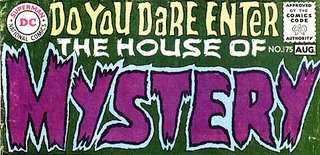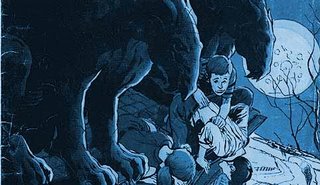The Mechanics of a Comic Story

One of the great advantages of the current era in comics is the massive number of worthy old comics that are back in print. I may take it for granted, but it truly is amazing that I can currently walk into a store, and if I choose to do so, buy affordable collections of old Metamorpho, or Killraven, or little Lulu. Frickin Little Lulu is back in print! As is Astro Boy... as is... 60s Green Arrow... as is the original Spider-Woman... as is Samurai Executioner.... But I digress.

As promised in my last post, today I'm taking a good look at the nuts and bolts of comics, with a look at a few things I've read lately. The first example we'll use is a story called Sir Greeley's Revenge, drawn by Frank Springer. The art is very nicely drawn, with expertly spotted blacks, and a slight scratchy illustration style common to the 1970s. The script is by long term comic book Scribe Otto Binder. As a point of comparison, we'll use The Man Who Hated Good Luck, drawn by Doug Wildey from a script by the ever prolific Unknown. Sir Greeley's Revenge was originally published in House of Mystery #181, 1969, and The Man Who Hated Good Luck was originally published in House of Secrets #17, 1959.
In the garage of comic book creation, a lot of the nuts and bolts will change over the course of ten years. The balance of words and pictures, the role of words in each panel, the number of panels per page, the shape and size of panels, the variability of panel size, the variability of "camera zooms", balloon placement, intro and ending routines, and sound effects lettering all change. Some of these are big things (size and number of panels), some of them are small things (intro routines and sound effects). But interestingly enough, even the small things are important in the final analysis. If a handful of these small elements all change at the same time, as they often do, the final effect is unmistakably different.
Let's run the numbers. The Man Who Hated Good Luck clocks in at 6 pages. Sir Greeley's Revenge, though it doesn't seem any longer, is actually twice as long (12 pages.) The Man is 33 panels long, while Greeley's is 52 panels long. Divided by page counts, that gives The Man an average of 5 and a half panels per page, and Greeley's an average of 4 and a third.
The Man has very regular panels, although rarely a perfect grid. Every page except the first and the last uses a three-tiered page of panels. It has exactly one page-deep panel, and one page-wide panel. The text is in the form of captions, speech balloons, and thought balloons, sometimes using all three in the same panel. Only one panel features no balloons of either type, but it does have a caption.
Greeley's shows a little variation in the shape and placement of panels. The pages have either two, three or four tiers of panels, though all the panels are still rectangular. In a now near-universal practice, it opens with a full page splash panel (unheard of in 1959). The story features 13 page-wide panels, and although it has some very thin, tall panels, not a single one is page-deep. (I'm not counting the splash page, of course.) The story uses speech balloons, thought balloons, and captions, though it does favor speech balloons over the other two. Greeley's has one wordless panel, showing the orphan protagonist chopping firewood with an axe.
Both stories have strong similarities: they're both obviously talky, and feature lightweight characterization. But the differences between the stories point out the changes that comics were going through, which only became more pronounced through the 70s, 80s, and 90s.
Next installment of The Mechanics of a Comic Story: More analysis of Sir Greeley's Revenge and The Man Who Hated Good Luck, featuring attention to plot! Drawing style! And more!

0 Comments:
Post a Comment
Subscribe to Post Comments [Atom]
<< Home